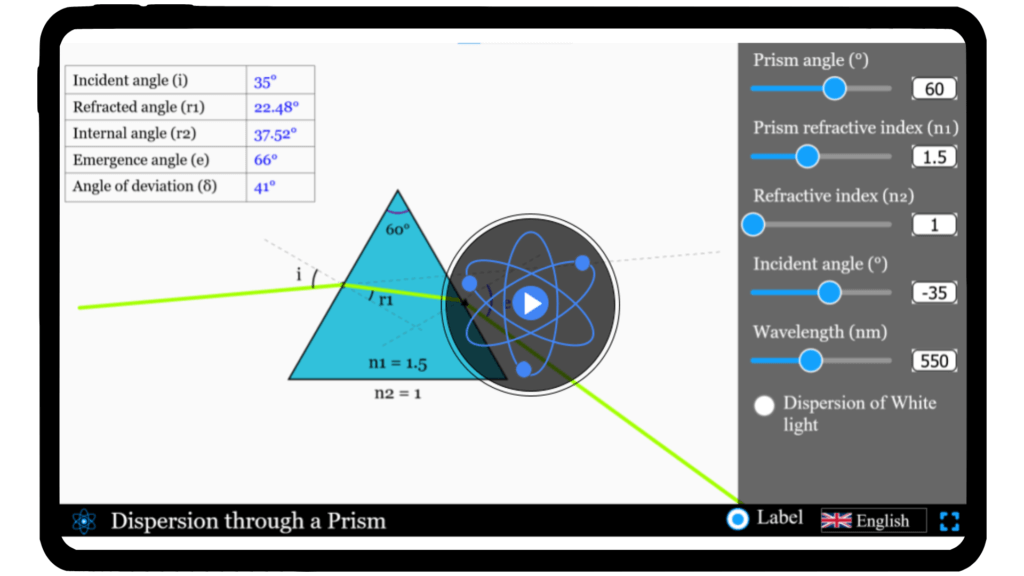Dispersion through a Prism Simulator
Explore how a triangular prism refracts and disperses light — experiment with prism angle, material index and incidence to see real-time effects with our interactive simulator.
Prism
Light behaves like a secret code — white light hides many colors until something like a prism tears them apart. A triangular prism splits light because each wavelength slows by a slightly different amount inside glass, so colors bend by different angles.
With our interactive Prism simulator you can recreate this classic optics demo: tweak the prism apex angle, material refractive index, and the incident beam to watch rays trace, colors spread, and the deviation change in real time. Explore minimum deviation, compare materials, and quantify how wavelength affects bending — start experimenting with light and dispersion in the Prism simulator now!
- Snell’s law: \( n_1 \sin i = n_2 \sin r_1
\) - Angle of Prism: \( r_1 + r_2 =A
\) - Angle of deviation: \( \delta = i+ e- A
\)
Mathematical description
where:
- \( n_1 \) & \( n_2 \) are the refractive indices of outside medium & Prism respectively
- \( i \) is the angle of incidence
- \( r_1 \) &\( r_2 \) are the angles of refraction at the boundaries of the two media
- \( e \) is the emergent angle
- \( A \) is the apex angle of the prism
- \( \delta \) is the angle of deviation
FAQs on Dispersion through Prism
Qus 1. What is a prism?
A triangular prism is a transparent optical element with flat surfaces that refract light, commonly used to disperse white light into its component colors and to deviate beams for spectroscopy and beam-manipulation.
Qus 2. Why does a prism produce a spectrum?
The refractive index of prism materials varies with wavelength (dispersion). Shorter wavelengths (blue/violet) typically have higher refractive indices than longer wavelengths (red) and so are deviated more — producing a spread of angles (a spectrum).
Qus 3. What does “refractive index varies with wavelength” mean?
The refractive index \( n \) of a transparent material is not a single fixed value — it depends on the wavelength (or color) of light. This phenomenon is called dispersion.
- For example, when we say “glass has \( n = 1.5
\) it usually means at a reference wavelength (commonly the yellow sodium D-line, \( \lambda = 589 nm
\) At shorter wavelengths (blue/violet light), the refractive index is slightly higher than 1.5.
At longer wavelengths (red/infrared light), the refractive index is slightly lower than 1.5.
So a single piece of glass actually has a curve\( n (\lambda)\), not one constant.
Qus 4. Why does refractive index depend on wavelength?
At the microscopic level, light interacts with bound electrons in the glass atoms.
These electrons oscillate at certain resonant frequencies (in the UV for most glasses).
When light of different wavelengths passes through, its speed changes slightly depending on how close it is to these resonances.
Shorter wavelengths (closer to UV resonance) are slowed more – > higher n
- Longer wavelengths (further from resonance) are slowed less – > lower n
\[
n_{violent} >n_{green} >n_{red} \]
Qus 5. What is deviation in a prism?
When a ray of light passes through a prism it bends towards the base at the first surface and then bends again at the second surface, emerging out.
The angle between the incident ray direction (before entering) and the emergent ray direction (after exiting) is called the angle of deviation
\[
\delta = i+ e- A
\]
where
- \( \delta\) is the deviation angle,
- \( i\) is the angle of incidence
- \( e\) is the angle of emergence
- \( A\) is the angle of the prism
Qus 6. What is minimum deviation?
If you vary the incident angle \( i\), the deviation \( \delta\) changes.
- At small \( i\), \( \delta\) is large
- As \( i\) increases, \( \delta\) decreases, reaches a minimum value, and then increases again.
- The smallest value of \( \delta\) is called the angle of minimum deviation \( \delta_{min}\).
At this condition:
The light ray travels symmetrically inside the prism.
That means:
\[
i =e \] and \[r_1 = r_2 = \frac{A}{2} \]
Qus 7. Why is minimum deviation important?
Minimum deviation provides a practical method to determine the refractive index of a prism. Suppose light is passing from air to prism, \( n_1 =1\). At minimum deviation:\[
n = \frac{\sin\left(\frac{A+\delta_{\min}}{2}\right)}{\sin\left(\frac{A}{2}\right)}
\]




